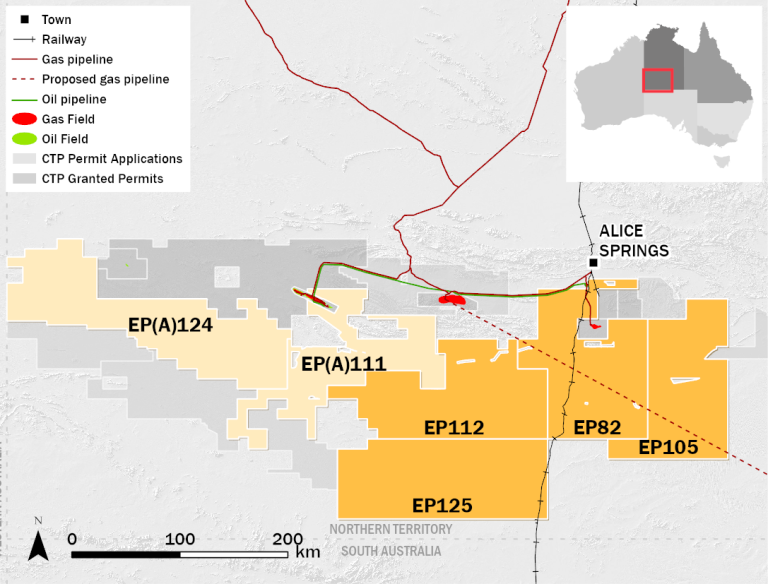
Tenement Information
The combined area is operated by Santos, with the exception of the EP 82DSA area which is operated by Central.
| Tenement | Approx Area (km²) | Location | Operator | CTP Consolidation Entity | Other JV Participants** | ||
| Registered Interest (%) | Beneficial Interest (%) | Participant Name | Beneficial Interest (%) | ||||
| EP 82* | 9,897* | Amadeus Basin NT | Santos | 29 | 60 | Santos | 40 |
| EP 105 | 9,750 | Amadeus/Pedirka Basin NT | Santos | 60 | 60 | Santos | 40 |
| EP(A)111 | 8,932 | Amadeus Basin NT | Santos | 100 | 50 | Santos | 50 |
| EP 112 | 11,511 | Amadeus Basin NT | Santos | 35 | 45 | Santos | 55 |
| EP(A)124 | 13,982 | Amadeus Basin NT | Santos | 100 | 50 | Santos | 50 |
| EP 125 | 12,761 | Amadeus Basin NT | Santos | 24 | 30 | Santos | 70 |
* Excludes EP 82DSA (1,489 km²), excised from the Joint Venture with Santos as part of arrangements in the purchase of Central’s interest in the Mereenie Oil and Gas Field.
Joint Venture
In October 2012, Central and Santos entered into a three-stage farm-in agreement, which involved Santos funding an extensive work program of seismic acquisition and several exploration wells. These activities were completed in 2019.
Peak Helium (Amadeus Basin) Pty Ltd agreed separately with Santos and Central to farmin to several tenements in March 2023 by free-carrying the costs for a number of new exploration wells targeting natural gas, helium and hydrogen, but failed to complete the transaction.
Description and Geology
The Southern Amadeus Basin is a large and underexplored region characterised by northwest trending structures in the northern area, and a central area dominated by an east-west central structural ridge. The southern area has a variety of structural styles including basement involved structural highs, compressional folds and salt-cored thrusted anticlines. The proven Larapintine petroleum system in the Northern Amadeus is not present southwards, however, source rocks are also recorded deeper in the stratigraphic succession including in the Cambrian Tempe Formation and Chandler Salt. The Neoproterozoic Pertatataka, Aralka, Finke Beds and Bitter Springs formations also show oil and gas source characteristics, in particular in the basal Gillen Member which provides the source for the Heavitree/basement play.
EP 82
Gas was discovered at Magee‑1 in 1992 where a test at a depth of 2,340 m flowed gas at a stabilised rate of 63 Mscfd, comprising natural gas, helium and nitrogen from a 6m zone of Heavitree Formation. Seismic data indicates a possible up dip location (Mahler) which has been identified as a site for a future exploration well. Other Heavitree/fractured basement leads within the block (Jackalope and Wolpertinger) are based on potential field data and are targets for natural gas and helium, however, additional seismic acquisition will be needed to delineate the leads.
EP 105
This permit is immediately east of and geologically similar to EP 82. Several leads have been identified from potential field data, the extensive 2013 regional seismic program, and field (outcrop) mapping. Regional seismic was acquired in 2013/14 and interpretation has identified the Mahler lead in adjacent EP 82 may extend into this permit. Other Heavitree/fractured basement leads within the block (Wolpertinger, Kraken, Thunderbird) are based on potential field data and are targets for natural gas and helium, however, additional seismic/fieldwork will be needed to delineate the leads.
EP 112
This permit contains a variety of structural styles, and several leads have been identified from potential field data and the extensive 2013 regional seismic program. Seismic acquired in 2013/14 and 2016/2018 identified the giant Dukas prospect at basement level. The Dukas-1 well was drilled in mid-April 2019 targeting natural gas and helium from the Heavitree Formation, which flowed at sub-commercial rates from Magee 1. Drilling was suspended due to extremely high pressures before penetration of the Heavitree Formation or basement. Drilling mud samples indicate the presence of hydrocarbons and helium. This permit contains a variety of structural styles, and additional Heavitree Formation/fractured basement leads (Sculthorpe, Beethoven, Grainger, Percy, Mozart) have been identified from potential field data as well as the previous seismic programs. A second Dukas well is being planned.
EP 125
In 2014, the joint venture operated by Santos drilled the exploration well Mt Kitty 1 to test a large basement structure with closure up to approximately 200 km². The target Heavitree Formation reservoir was absent, but hydrocarbon and helium gas flows were recorded from fractured igneous basement, opening a new play type. This permit contains a variety of structural styles, and additional opportunities have been identified from potential field data and the extensive 2013 and 2016/2018 seismic data.
It is planned to re-enter the Mt Kitty well through the Jacko Bore lateral well, targeting commercial flows of helium.
Exploration
The Southern Amadeus region contains a variety of structural styles and additional Heavitree Formation/Fractured basement leads have been identified from potential field data as well as the 2013/14 and 2016/18 seismic programs.
Opportunities
The size of the acreage and leads identified to date has encouraged the joint venture to plan exploration wells at three locations identified as worthy of drilling. The percentage of helium recovered in known discoveries is in the range 4% to 9%, which is very high compared with worldwide analogues, and may represent a standalone commercial opportunity.
